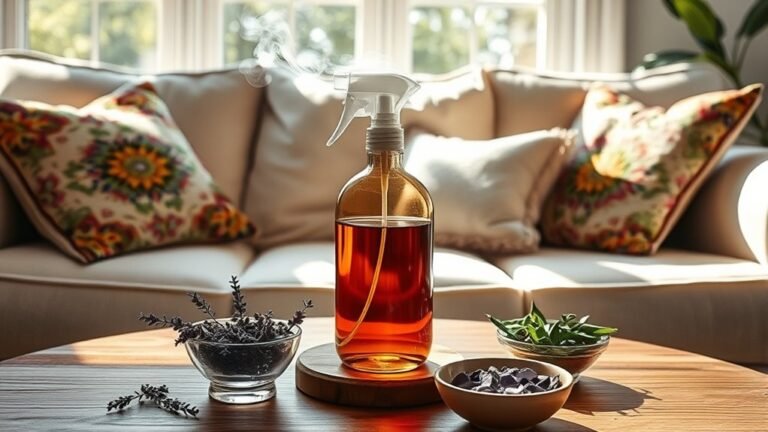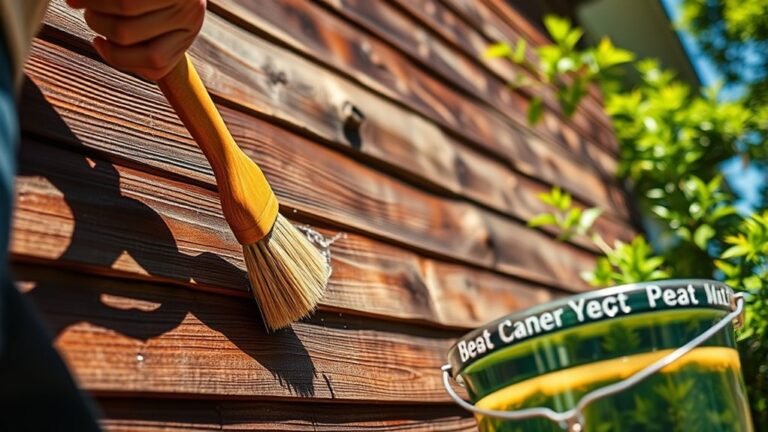Budget-Friendly DIY Cleaning Products for Allergens
You can easily make budget-friendly DIY cleaners to fight household allergens like dust mites, pet dander, and mold. Use simple ingredients like white vinegar, baking soda, and essential oils to create effective sprays, polishes, and carpet treatments. These natural solutions reduce allergens without harsh chemicals and save you money. Regular cleaning with these homemade products helps maintain a fresher, healthier home. Keep exploring, and you’ll discover even more tips to improve your indoor air quality naturally.
Common Household Allergens and Their Sources

There are five main allergens you’re likely to find in your home: dust mites, pet dander, mold spores, pollen, and cockroach droppings. Dust mites thrive in bedding and upholstery, making regular cleaning routines essential to reduce these allergen triggers. Pet allergens, like dander, can linger in the air and on surfaces, impacting your indoor air quality. Mold growth often hides in damp areas, releasing spores that worsen seasonal allergies. Pollen sources from open windows or brought in on clothes can also invade your space, amplifying reactions. To reclaim your freedom from allergy symptoms, understanding these common household allergens and their sources helps you target your cleaning efforts effectively and breathe easier every day.
Essential Ingredients for DIY Allergen Cleaners
Cleaning products that target allergens effectively often rely on a few key ingredients you might already have at home. Vinegar is a superstar here, thanks to its natural acidity that breaks down allergens like dust and pet dander, plus its antibacterial properties. You’ll also want to tap into the power of citrus extracts—not just for their fresh scent but because they help dissolve grime and inhibit mold growth, common allergen sources. Baking soda is another ally, gently scrubbing surfaces without harsh chemicals. Together, these ingredients let you create potent, budget-friendly cleaners that keep allergens at bay without locking you into pricey, chemical-laden products. Embracing these essentials means you’re reclaiming control over your home’s air and surfaces, using simple, effective ingredients that promote your freedom from allergens.
How to Make a Natural All-Purpose Cleaner

To make your own natural all-purpose cleaner, you’ll need a few essential ingredients like vinegar, baking soda, and a few drops of essential oil. Follow a simple step-by-step guide to mix them safely and effectively. I’ll also share the best tips for using your cleaner to keep allergens at bay around your home.
Essential Ingredients Needed
Although making a natural all-purpose cleaner might seem complicated, you’ll find it requires just a few simple ingredients you probably already have at home. These essentials not only tackle allergens effectively but also give you the freedom to customize your cleaner’s scent and strength. Here’s what you’ll need:
- White vinegar for its powerful vinegar benefits, like cutting through grime and neutralizing odors
- Water, as a gentle diluent to balance the formula
- Baking soda to help lift dirt and neutralize allergens
- Essential oils such as lavender or tea tree for their antimicrobial properties and fresh fragrance
- A spray bottle to mix and apply your cleaner effortlessly
With these ingredients, you’re set to create a natural, budget-friendly solution that keeps your space fresh and allergen-free.
Step-by-Step Mixing Guide
You’ll need just five simple steps to mix your natural all-purpose cleaner. First, gather your ingredients: distilled water, white vinegar, rubbing alcohol, liquid castile soap, and essential oils. Next, pour one cup of distilled water into a spray bottle. Then, add one cup of white vinegar to tackle allergens effectively. After that, mix in half a cup of rubbing alcohol for disinfecting power. Fourth, stir in one teaspoon of liquid castile soap to break down grime gently. Finally, add 10-15 drops of your favorite essential oils for a revitalizing scent and extra allergen-fighting benefits. Close the bottle tightly and shake well to combine. This DIY cleaning formula promotes allergen awareness by using natural, safe ingredients that keep your space fresh and healthy.
Best Usage Tips
Now that you’ve got your natural all-purpose cleaner mixed, knowing how to use it effectively will make a big difference. To keep your home allergen-free and enjoy the freedom of a toxin-free space, follow these best usage tips:
- Stick to regular cleaning schedules to prevent buildup and keep allergens at bay.
- Use a spray bottle for easy application and control over how much you use.
- Test on small areas first to verify surfaces won’t be damaged.
- Store your cleaner in a cool, dark place to maintain its potency—these storage tips help it last longer.
- Shake well before each use to mix ingredients evenly for maximum effectiveness.
Creating a Dust-Reducing Furniture Polish

When you want to keep dust at bay while caring for your furniture, making your own dust-reducing polish is a simple and effective solution. You can mix equal parts olive oil and white vinegar with a few drops of lemon essential oil to create a natural furniture polish. This blend not only shines wood surfaces but also helps with dust reduction by creating a slight barrier that discourages dust buildup. Applying this polish with a soft cloth lets you clean and protect your furniture in one step, freeing you from harsh chemicals and costly store-bought products. Plus, you control the ingredients, ensuring your space remains allergen-friendly. Give it a try—you’ll enjoy cleaner surfaces and the freedom of a homemade solution tailored to your needs.
DIY Carpet and Upholstery Spray to Minimize Allergens
Keeping your furniture dust-free is a great start, but carpets and upholstery can also harbor allergens that affect indoor air quality. You can easily whip up a DIY carpet and upholstery spray to tackle this. This spray helps with carpet cleaning and upholstery maintenance without harsh chemicals. Here’s what you’ll need:
- 1 cup distilled water
- 1/2 cup white vinegar
- 10 drops tea tree oil (natural antifungal)
- 10 drops eucalyptus oil (reduces allergens)
- A spray bottle
Mix everything, spray lightly on carpets and upholstery, then let it dry. This simple blend freshens and minimizes allergens, giving you freedom from pricey cleaners and worry about indoor air quality. Regular use keeps your home healthier and allergen-free.
Homemade Air Purifier Sprays for Fresh Indoor Air
A few simple ingredients can transform your indoor air with a homemade air purifier spray. You don’t need fancy gadgets—just water, a bit of witch hazel or rubbing alcohol, and your favorite essential oil blends. Try combining eucalyptus, tea tree, and lemon oils for a rejuvenating, allergen-fighting mix. Using the right spray bottle techniques makes all the difference: shake well before each use to blend oils evenly, and spritz lightly around rooms to avoid dampness. This DIY spray not only freshens your space but also helps reduce airborne allergens, giving you cleaner, more breathable air. It’s a budget-friendly way to reclaim your home’s freedom from irritants, all while enjoying natural scents you control.
Safe and Effective Pet Dander Cleaning Solutions
If you’re dealing with pet dander, using natural removers can help keep allergens under control without harsh chemicals. You can also make homemade allergen sprays that neutralize dander on surfaces and fabrics. These solutions are both safe for your pets and effective at improving your indoor air quality.
Natural Pet Dander Removers
When you’re dealing with pet dander, choosing natural removers can make a big difference in maintaining a healthy home environment. These solutions not only help with allergen reduction but also let you avoid harsh chemicals, giving you freedom to create a safe space for you and your pets. Here are some natural pet dander removers you can try:
- Microfiber cloths: Trap dander effectively without chemicals.
- Vacuum with HEPA filter: Captures tiny allergens from floors and furniture.
- Baking soda: Sprinkle on carpets, wait 15 minutes, then vacuum.
- Essential oils (like eucalyptus or lavender): Add a few drops to cleaning water for natural freshness.
- Regular pet grooming: Reduces dander at the source.
These simple tools keep your home fresh while supporting allergen reduction naturally.
Homemade Allergen Sprays
Although pet dander can be tough to manage, homemade allergen sprays offer a simple and safe way to keep your space clean without harsh chemicals. You can create sprays using allergen targeting ingredients like distilled water, white vinegar, and a small amount of rubbing alcohol to neutralize dander effectively. Adding natural fragrance options such as lavender or eucalyptus essential oils not only freshens the air but also provides additional allergen-fighting benefits. Simply mix these ingredients in a spray bottle, shake well, and spritz on fabrics, furniture, or pet beds. This DIY approach gives you control over what goes into your home, letting you maintain a fresh, allergen-reduced environment without relying on commercial products full of synthetic chemicals. It’s freedom in a bottle, tailored by you.
Tips for Maintaining an Allergen-Free Home Environment
Keeping your home allergen-free takes consistent effort and smart habits. To enjoy the freedom of a clean, breathable space, you need allergen awareness and solid cleaning routines. Here are tips to help you maintain an allergen-free environment without hassle:
Creating an allergen-free home requires awareness, consistent effort, and effective cleaning habits for a healthier living space.
- Vacuum regularly with a HEPA filter to trap dust and pet dander.
- Wash bedding weekly in hot water to eliminate dust mites.
- Use your DIY allergen sprays on surfaces to reduce irritants naturally.
- Keep windows closed during high pollen days to minimize outdoor allergens.
- Declutter often to reduce dust-collecting items and improve air flow.
Frequently Asked Questions
Can DIY Allergen Cleaners Be Stored Long-Term Without Losing Effectiveness?
You can store DIY allergen cleaners for long term storage, but you’ll want to keep a few things in mind to maintain cleaner effectiveness. Keep your mixtures in airtight containers away from direct sunlight and extreme temperatures. Over time, some natural ingredients may lose potency, so it’s best to label your cleaners with the date you made them. This way, you stay free from constant remaking while ensuring your cleaner still works well.
Are These Homemade Cleaning Products Safe for Children and Pets?
You’ll want to prioritize child safety and limit pet exposure when using any homemade cleaning products. While many DIY cleaners use natural ingredients, some can still irritate sensitive skin or harm curious pets if ingested. Always store products out of reach, label them clearly, and test in small areas first. By taking these precautions, you can enjoy the freedom of DIY cleaning without worrying about your little ones or furry friends.
How Do I Test if a DIY Cleaner Causes Allergic Reactions?
Did you know nearly 1 in 5 people suffer from allergic reactions to household products? To keep your freedom intact, always do a patch test before using a new DIY cleaner. Apply a small amount on your skin, wait 24 hours, and watch for redness or irritation. This helps spot ingredient sensitivity early, so you’re free to enjoy your homemade cleaner without unexpected reactions. It’s a simple, empowering step!
Can I Use Essential Oils in All DIY Allergen Cleaning Recipes?
You can use essential oils in many DIY allergen cleaning recipes, but not all types suit every purpose. Some essential oil types, like tea tree or eucalyptus, are great for their antimicrobial properties, while others might cause irritation. When mixing cleaning oil blends, start small and test for sensitivity. You’ve got the freedom to experiment, but always prioritize safety by choosing oils known for gentle, effective cleaning without triggering allergies.
What Are the Cost Comparisons Between DIY and Commercial Allergen Cleaners?
When you delve into a cost analysis, you’ll find DIY allergen cleaners often save you money compared to commercial options. By sourcing ingredients like vinegar, baking soda, and essential oils yourself, you cut out brand markups and packaging costs. Plus, you get the freedom to customize your formulas. While commercial cleaners might offer convenience, making your own lets you control both quality and price, giving you a budget-friendly, flexible cleaning solution.






